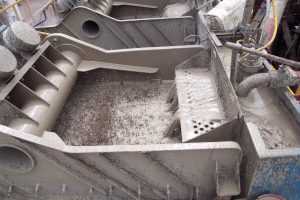Since early days of the oil industry, gas liberated from the formation during drilling has been looked at as a means to predict what type of hydrocarbons are lurking in the reservoir. Various ratios and procedures have been tried and tested with various measures of success in reservoirs around the world. The major lesson learned is that every reservoir is different, and that you just can’t trust things to be exactly the same from one place to another.
 With the rise of the machines – downhole MWD/LWD ‘machines’ – work with gas ratios as a serious predictive tool slowed down or stopped, becoming another arcane tool of mud-logging folk; a source of data that was always present but rarely used in earnest. Granted, the accuracy of gas data depends on a number of factors that include, at a high level, the formation itself, drilling mud, drilling parameters, lag time calculation, and gas extraction and measurement equipment, but despite the various possible drawbacks, gas data, especially the ratios, is still very useful when looked at in the right way. (And strangely, that right way includes a certain amount of squinty-eyed skepticism.)
With the rise of the machines – downhole MWD/LWD ‘machines’ – work with gas ratios as a serious predictive tool slowed down or stopped, becoming another arcane tool of mud-logging folk; a source of data that was always present but rarely used in earnest. Granted, the accuracy of gas data depends on a number of factors that include, at a high level, the formation itself, drilling mud, drilling parameters, lag time calculation, and gas extraction and measurement equipment, but despite the various possible drawbacks, gas data, especially the ratios, is still very useful when looked at in the right way. (And strangely, that right way includes a certain amount of squinty-eyed skepticism.)
Diversified Well Logging uses a process that allows daily collaboration between the wellsite, the regional office, and a squinty-eyed data analyst who provides a triple-check of the gas data. This triple-check assures DWL and their Clients that the data is good, and that any issues have been addressed in a timely manner. Quality is important.
In the unconventional, tight formations that are currently drilled in North America, DWL uses gas curves and ratios to (1) aid as a primary quality check, and (2) evaluate what is going on downhole. The traditional ratios, with their traditional setpoints may not point directly to the type of hydrocarbon in place, but they can still be used to
- Pick or corroborate formation tops
- Indicate subtle changes in ‘homogenous’ formations
- Indicate major changes in formations
- As an aid in geosteering (preferably along with DWL’s Chemosteering)
- Indicate potential changes in formation fluids
- And, with squinty-eyed skepticism, point directly to the type of hydrocarbon in place
As a cost-effective formation evaluation technique, DWL believes that gas analysis provides important insights into the downhole environment.
It may be an arcane tool of mud-logging folk, but it is a very good tool.
Gas, used alongside our XRF service allows us to offer HYBRID MUD LOGGING … Hybrid Mud Logging used alongside our Geosteering service allows us to offer CHEMOSTEERING … and along with hi-data-density AUTOMATED REMOTE MUDLOGGING, if hi-data-density cuttings sampling is needed, we offer Operators the full benefits of …

 Diversified Well Logging
Diversified Well Logging